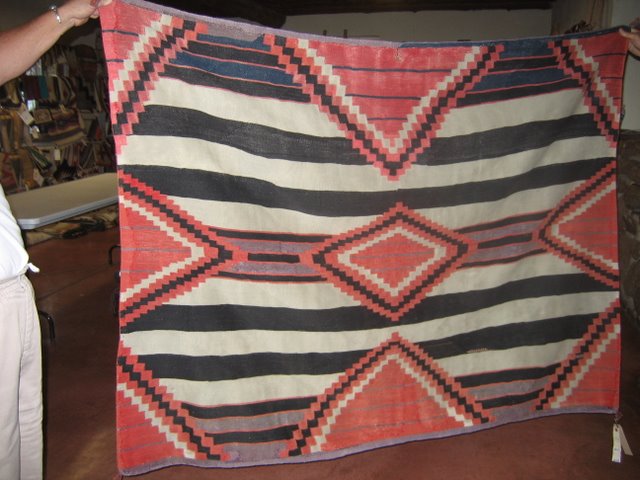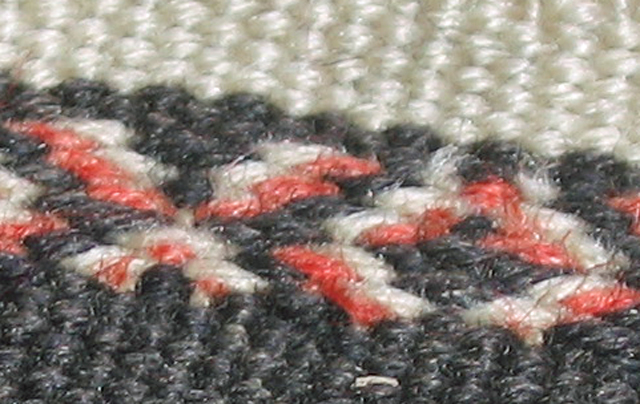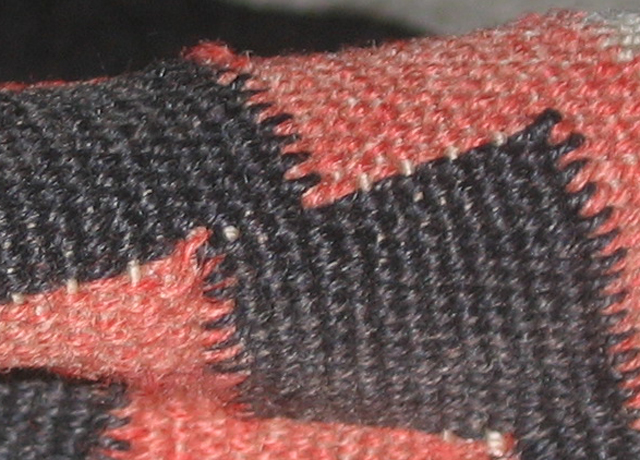Is It Bayeta?
Many people, especially people who read this site, are familiar with the $500,000 Chief Blanket that was featured on the Antiques Roadshow and occasionally I get an email from someone who really, really, really hopes that they own a similar treasure. I haven’t found one so far, but I have gotten to see some really interesting pieces and I hope I’ve been able to help the owners understand better what they have even if it wasn’t a six figure 401k in disguise. Determining the worth of a vintage textile is a calculus that involves fiber identification, dye analysis and examination of design geometry and motifs to build a picture of historic context. One of the factors that comes into play with 19th century examples is the use of bayeta, which places a textile into the period before the 1880’s and also greatly increases the value because it is very rare and seldom seen on the market.
The source of red coloration usually seen in Navajo textiles is aniline dye, either used to dye commercial Germantown yarns or to dye wool hand spun by the weaver. By the 1880’s these dyes had almost completely replaced the earlier source of red coloration used in Navajo textiles: bayeta, a red woolen flannel cloth that was raveled and usually respun. The red color in bayeta usually came from carminic acid derived from the Mesoamerican cochineal beetle but laccaic acid from the lac beetle found in Asia was sometimes used. The blanket in the picture below allegedly is woven with some of these raveled yarns, but is this claim accurate? Let’s see…..(click on any picture for a closer look)
From a design perspective, the weaving is a Third Phase Chief Blanket. This is the last and most complex of the Chief Blanket design geomeries and it consists of nine diamond and triangular design areas superimposed over a striped background. Second phase blankets use square or rectangular design motifs and First Phase patterns are simple stripes. Third Phase blankets emerged prior to the 1880’s and were woven during the period when bayeta was being used, so nothing about the design rules out the use of bayeta. Now, let’s take a close look at the yarns.
You can see that the yarns used are smooth plied yarns with a beautiful patina. This particular close-up also shows a distinctive detail that I’ve never seen in a any other Navajo piece: a twill weave section that seems to be a sort of signature. You can also see that the red matches the other yarns in terms of size and in another view below, you can also see how evenly the yarns are spun and that the colors of both the red and black are very even. You can also see the plies in the red yarns and you can see how well they match.
The plies themselves don’t rule out raveled bayeta. Bayeta yarns usually are respun and have two to six plies, and black cloth could have just as easily have been raveled as red although I’ve never seen any references to this. The even spin of the plied yarns suggests commercial yarns to me, but this is based on what textile analysts call the “experienced eye” technique for dye analysis. Further corroboration is the appearance of the areas which look purplish because early blue aniline dyes often fade to these shades. How to tell for sure? We would need to submit a sample of the wool to a lab that does scientific analysis. Here, a small sample of the wool would be spectrographically analyzed and compared to known samples. This is a technique that is usually done by museums or when a determination will mean a significant increase in the appraised value of the textile. That hadn’t been done in the case of this blanket, but absent that analysis my opinion is that this blanket was woven with commercial yarns and not with raveled bayeta.



